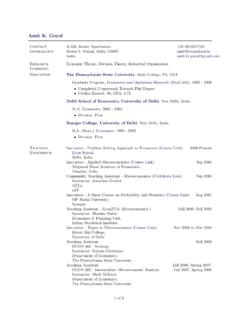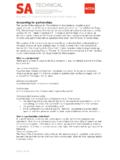Transcription of Modern Information Retrieval: A Brief Overview - Amit Singhal
1 Modern Information retrieval : A Brief OverviewAmit SinghalGoogle, thousands of years people have realized the importance of archiving and finding Information . Withthe advent of computers, it became possible to store large amounts of Information ; and finding usefulinformation from such collections became a necessity. The field of Information retrieval (IR) was bornin the 1950s out of this necessity. Over the last forty years,the field has matured considerably. SeveralIR systems are used on an everyday basis by a wide variety of users. This article is a Brief Overview ofthe key advances in the field of Information retrieval , and a description of where the state-of-the-art isat in the Brief HistoryThe practice of archiving written Information can be tracedback to around 3000 BC, when the Sumeriansdesignated special areas to store clay tablets with cuneiform inscriptions. Even then the Sumerians realizedthat proper organization and access to the archives was critical for efficient use of Information .
2 They developedspecial classifications to identify every tablet and its content. ( awonderful historical perspective on Modern libraries.)The need to store and retrieve written Information became increasingly important over centuries, especiallywith inventions like paper and the printing press. Soon after computers were invented, people realized that theycould be used for storing and mechanically retrieving largeamounts of Information . In 1945 Vannevar Bushpublished a ground breaking article titled As We May Think that gave birth to the idea of automatic access tolarge amounts of stored knowledge. [5] In the 1950s, this idea materialized into more concrete descriptions ofhow archives of text could be searched automatically. Several works emerged in the mid 1950s that elaboratedupon the basic idea of searching text with a computer. One of the most influential methods was described by in 1957, in which (put simply) he proposed using words asindexing units for documents and measuringword overlap as a criterion for retrieval .
3 [17]Several key developments in the field happened in the 1960s. Most notable were the development of theSMART system by Gerard Salton and his students, first at Harvard University and later at Cornell Univer-sity; [25] and the Cranfield evaluations done by Cyril Cleverdon and his group at the College of Aeronautics inCranfield. [6] The Cranfield tests developed an evaluation methodology for retrieval systems that is still in useby IR systems today. The SMART system, on the other hand, allowed researchers to experiment with ideas toCopyright 2001 IEEE. Personal use of this material is permitted. However, permission to reprint/republish this material for ad-vertising or promotional purposes or for creating new collective works for resale or redistribution to servers or lists, or to reuse anycopyrighted component of this work in other works must be obtained from the of the IEEE Computer Society Technical Committee on Data Engineering1improve search quality.
4 A system for experimentation coupled with good evaluation methodology allowed rapidprogress in the field, and paved way for many critical 1970s and 1980s saw many developments built on the advances of the 1960s. Various models for do-ing document retrieval were developed and advances were made along all dimensions of the retrieval new models/techniques were experimentally proven tobe effective on small text collections (several thou-sand articles) available to researchers at the time. However, due to lack of availability of large text collections,the question whether these models and techniques would scale to larger corpora remained unanswered. Thischanged in 1992 with the inception of Text retrieval Conference, or TREC1. [11] TREC is a series of evalu-ation conferences sponsored by various US Government agencies under the auspices of NIST, which aims atencouraging research in IR from large text large text collections available under TREC, many old techniques were modified, and many new tech-niques were developed (and are still being developed) to do effective retrieval over large collections.
5 TREC hasalso branched IR into related but important fields like retrieval of spoken Information , non-English languageretrieval, Information filtering, user interactions with aretrieval system, and so on. The algorithms developedin IR were the first ones to be employed for searching the WorldWide Web from 1996 to 1998. Web search,however, matured into systems that take advantage of the cross linkage available on the web, and is not a focusof the present article. In this article, I will concentrate on describing the evolution of Modern textual IR systems( [27, 33, 16] are some good IR resources).2 Models and ImplementationEarly IR systems were boolean systems which allowed users tospecify their Information need using a complexcombination of boolean ANDs, ORs and NOTs. Boolean systems have several shortcomings, , there isno inherent notion of document ranking, and it is very hard for a user to form a good search request.
6 Eventhough boolean systems usually return matching documents in some order, , ordered by date, or some otherdocument feature, relevance ranking is often not critical in a boolean system. Even though it has been shown bythe research community that boolean systems are less effective than ranked retrieval systems, many power usersstill use boolean systems as they feel more in control of the retrieval process. However, most everyday usersof IR systems expect IR systems to do ranked retrieval . IR systems rank documents by their estimation of theusefulness of a document for a user query. Most IR systems assign a numeric score to every document and rankdocuments by this score. Several models have been proposed for this process. The three most used models in IRresearch are the vector space model, the probabilistic models, and the inference network Vector Space ModelIn the vector space model text is represented by a vector ofterms. [28] The definition of a term is not inherentin the model, but terms are typically words and phrases.
7 If words are chosen as terms, then every word in thevocabulary becomes an independent dimension in a very high dimensional vector space. Any text can then berepresented by a vector in this high dimensional space. If a term belongs to a text, it gets a non-zero value in thetext-vector along the dimension corresponding to the any text contains a limited set of terms (thevocabulary can be millions of terms), most text vectors are very sparse. Most vector based systems operate inthe positive quadrant of the vector space, , no term is assigned a negative assign a numeric score to a document for a query, the model measures thesimilaritybetween the queryvector (since query is also just text and can be converted into a vector) and the document vector. The similaritybetween two vectors is once again not inherent in the model. Typically, the angle between two vectors is usedas a measure of divergence between the vectors, and cosine ofthe angle is used as the numeric similarity (since1 has the nice property that it is for identical vectors and for orthogonal vectors).
8 As an alternative,the inner-product (or dot-product) between two vectors is often used as a similarity measure. If all the vectorsare forced to be unit length, then the cosine of the angle between two vectors is same as their dot-product. If~Dis the document vector and~Qis the query vector, then the similarity of documentDto queryQ(or score ofDforQ) can be represented as:Sim(~D;~Q)=Xti2Q;DwtiQ wtiDwherewtiQis the value of theith component in the query vector~Q, andwtiDis theith component in thedocument vector~D. (Since any word not present in either the query or the document has awtiQorwtiDvalueof 0, respectively, we can do the summation only over the terms common in the query and the document.) Howwe arrive atwtiQandwtiDis not defined by the model, but is quite critical to the searcheffectiveness of an often referred to as theweightof term-iin documentD, and is discussed in detail in Section Probabilistic ModelsThis family of IR models is based on the general principle that documents in a collection should be rankedby decreasing probability of their relevance to a query.
9 This is often calledthe probabilistic ranking principle(PRP). [20] Since true probabilities are not available to anIR system, probabilistic IR modelsestimatetheprobability of relevance of documents for a query. This estimation is the key part of the model, and this is wheremost probabilistic models differ from one another. The initial idea of probabilistic retrieval was proposed byMaron and Kuhns in a paper published in 1960. [18] Since then,many probabilistic models have been proposed,each based on a different probability estimation to space limitations, it is not possible to discuss the details of these models here. However, the fol-lowing description abstracts out the common basis for thesemodels. We denote the probability of relevancefor documentDbyP(RjD). Since this ranking criteria is monotonic under log-odds transformation, we canrank documents bylogP(RjD)P( RjD), whereP( RjD)is the probability that the document is non-relevant.
10 This,bysimple bayes transform, becomeslogP(DjR) P(R)P(Dj R) P( R). Assuming that the prior probability of relevance, ,P(R),is independent of the document under consideration and thusis constant across documents,P(R)andP( R)arejust scaling factors for the final document scores and can be removed from the above formulation (for rankingpurposes). This further simplifies the above formulation to:logP(DjR)P(Dj R).Based on the assumptions behind estimation ofP(DjR), different probabilistic models start diverging atthis point. In the simplest form of this model, we assume thatterms (typically words) are mutually independent(this is often called theindependence assumption), andP(DjR)is re-written as a product of individual termprobabilities, , probability of presence/absence of aterm in relevant/non-relevant documents:P(DjR)=Yti2Q;DP(tijR) Ytj2Q; D(1 P(tjjR))which uses probability of presence of a termtiin relevant documents for all terms that are common to the queryand the document, and the probability of absence of a termtjfrom relevant documents for all terms that arepresent in the query and absent from the document.








